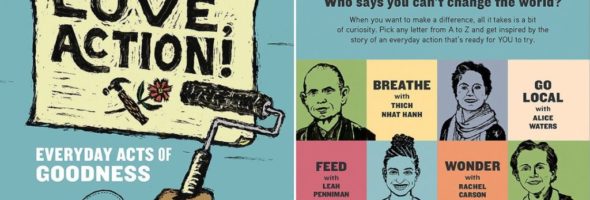Bring-A-Book #5
Book: “Peace, Love, Action” By Tanya Zabinski

Group: Ruth, Katrina, Anne, John, Dane, Brie
Question: Does your book support thin or thick democracy and resistance? Positive or negative resistance? Is it really resistance at all?
- This book supports thick democracy by explaining the actions of many people who practiced and promoted thick democracy. It gives examples of what impacts one can have when they practice thick democracy.
- The book encourages action, with each section ending with a “What you can do” list of ideas for students.
- Resistance as founded in a practice of love and a goal of peace
- Focuses on individual and collective goals
- This book does exemplify resistance by giving context to what resistance is, how it has been embodied and what impacts it can have on power structures. The aim of this book is to inspire resistance. To show it can be a force for positive change.
Collective Art Project: Our different paths up the mountain to watch the moon together (related to the introduction to the book)
Grade 8
Big Idea:
- Contacts and conflicts between peoples stimulated significant cultural, social, political change.
- Changing ideas about the world created tension between people wanting to adopt new ideas and those wanting to preserve established traditions.
Curricular Competencies:
- Assess the significance of people, places events, or developments at particular times and places.
- Explain different perspectives on past or present people, places, issues, or events, and compare the values, worldviews, and beliefs of human cultures and societies in different times and places
- Determine which causes most influenced particular decisions, actions, or events, and assess their short-and long-term consequences (cause and consequence)
Curricular Content:
- Philosophical and cultural shifts
- Social, political, and economic systems and structures, including those of at least one indigenous civilization
Curricular Connections
The project would also link to aspects of English Language Arts, Science, and Visual Arts curriculum.
Collective Art Project
- Begin with a discussion about what we envision as our goals for our community
- Reading and breaking down the local districts strategic plan may help students to determine local issues that they are interested in or directly impact their life and interests
- Find examples from the book where activists have worked to address some of the same issues that our local districts are concerned with
- Create a collective art piece that can be displayed in the classroom or in the halls for all to see (can we inspire our larger school community to join in our activism?)
- Each student writes, draws, or creates a piece of art [on a long piece of paper that looks like a snaking river or path] about their goals for activism/resistance and what they feel passionate about
- Emphasize that we can all work towards an ideal while focussing on our personal passions
- Once completed individually, find the paths/goals that have similar themes and perhaps create pods to combine that collective energy
- Paste or pin the “Paths” onto a larger Mountain to represent that we are all walking our own paths to reach the same goal of Peace (eg, image below)
- Next, create a plan! How can you take action to work towards your goal? What are the first steps? “Just take the next right step”
Other Ideas for using this book in the classroom
- This book could be used if you have a student who wants to work alone; get them to find someone in the book that inspires them, with potential guiding questions.
- We would want to have multiple copies in the classroom, because the book would most likely be used in an exploratory way. You could also use it at a centre.
- You could read out one section to explore a specific theme with class discussion.
- Use it within a unit we are already working on – pull out all the people in the book who have done work related to our unit topic. Ask students to pick who they are feeling an affinity for to further explore through inquiry.

